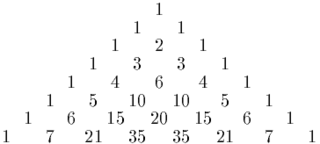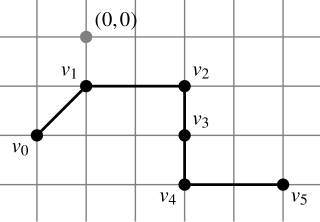
In mathematics, the binomial coefficients are the positive integers that occur as coefficients in the binomial theorem. Commonly, a binomial coefficient is indexed by a pair of integers n ≥ k ≥ 0 and is written It is the coefficient of the xk term in the polynomial expansion of the binomial power (1 + x)n; this coefficient can be computed by the multiplicative formula
In elementary algebra, the binomial theorem (or binomial expansion) describes the algebraic expansion of powers of a binomial. According to the theorem, it is possible to expand the polynomial (x + y)n into a sum involving terms of the form axbyc, where the exponents b and c are nonnegative integers with b + c = n, and the coefficient a of each term is a specific positive integer depending on n and b. For example, for n = 4,
In mathematics, Pascal's triangle is a triangular array of the binomial coefficients which play a crucial role in probability theory, combinatorics, and algebra. In much of the Western world, it is named after the French mathematician Blaise Pascal, although other mathematicians studied it centuries before him in Persia, India, China, Germany, and Italy.
In mathematics, the discriminant of a polynomial is a quantity that depends on the coefficients and allows deducing some properties of the roots without computing them. More precisely, it is a polynomial function of the coefficients of the original polynomial. The discriminant is widely used in polynomial factoring, number theory, and algebraic geometry.

In mathematics, factorization (or factorisation, see English spelling differences) or factoring consists of writing a number or another mathematical object as a product of several factors, usually smaller or simpler objects of the same kind. For example, 3 × 5 is an integer factorization of 15, and (x – 2)(x + 2) is a polynomial factorization of x2 – 4.
In mathematics, Stirling numbers arise in a variety of analytic and combinatorial problems. They are named after James Stirling, who introduced them in a purely algebraic setting in his book Methodus differentialis (1730). They were rediscovered and given a combinatorial meaning by Masanobu Saka in 1782.
Hilbert's tenth problem is the tenth on the list of mathematical problems that the German mathematician David Hilbert posed in 1900. It is the challenge to provide a general algorithm that, for any given Diophantine equation, can decide whether the equation has a solution with all unknowns taking integer values.

In number theory and combinatorics, a partition of a non-negative integer n, also called an integer partition, is a way of writing n as a sum of positive integers. Two sums that differ only in the order of their summands are considered the same partition. For example, 4 can be partitioned in five distinct ways:
In mathematics, a polynomial sequence, i.e., a sequence of polynomials indexed by non-negative integers in which the index of each polynomial equals its degree, is said to be of binomial type if it satisfies the sequence of identities
In mathematics, the falling factorial is defined as the polynomial
In mathematics, especially in the field of algebra, a polynomial ring or polynomial algebra is a ring formed from the set of polynomials in one or more indeterminates with coefficients in another ring, often a field.
126 is the natural number following 125 and preceding 127.
In combinatorial mathematics, the Bell polynomials, named in honor of Eric Temple Bell, are used in the study of set partitions. They are related to Stirling and Bell numbers. They also occur in many applications, such as in Faà di Bruno's formula.
In mathematics, specifically in commutative algebra, the elementary symmetric polynomials are one type of basic building block for symmetric polynomials, in the sense that any symmetric polynomial can be expressed as a polynomial in elementary symmetric polynomials. That is, any symmetric polynomial P is given by an expression involving only additions and multiplication of constants and elementary symmetric polynomials. There is one elementary symmetric polynomial of degree d in n variables for each positive integer d ≤ n, and it is formed by adding together all distinct products of d distinct variables.

In mathematics the nth central binomial coefficient is the particular binomial coefficient

In mathematics, particularly in combinatorics, a Stirling number of the second kind is the number of ways to partition a set of n objects into k non-empty subsets and is denoted by or . Stirling numbers of the second kind occur in the field of mathematics called combinatorics and the study of partitions. They are named after James Stirling.
In mathematics, a univariate polynomial of degree n with real or complex coefficients has n complex roots, if counted with their multiplicities. They form a multiset of n points in the complex plane. This article concerns the geometry of these points, that is the information about their localization in the complex plane that can be deduced from the degree and the coefficients of the polynomial.
In the mathematical field of combinatorics, the q-Pochhammer symbol, also called the q-shifted factorial, is the product

In combinatorics, a lattice pathL in the d-dimensional integer lattice of length k with steps in the set S, is a sequence of vectors such that each consecutive difference lies in S. A lattice path may lie in any lattice in , but the integer lattice is most commonly used.
Narayana polynomials are a class of polynomials whose coefficients are the Narayana numbers. The Narayana numbers and Narayana polynomials are named after the Canadian mathematician T. V. Narayana (1930–1987). They appear in several combinatorial problems.





















